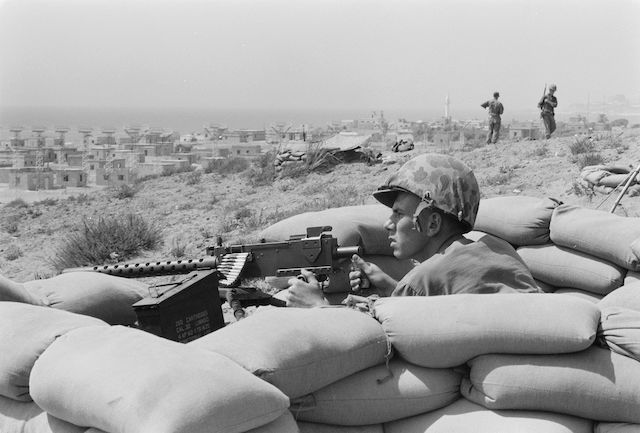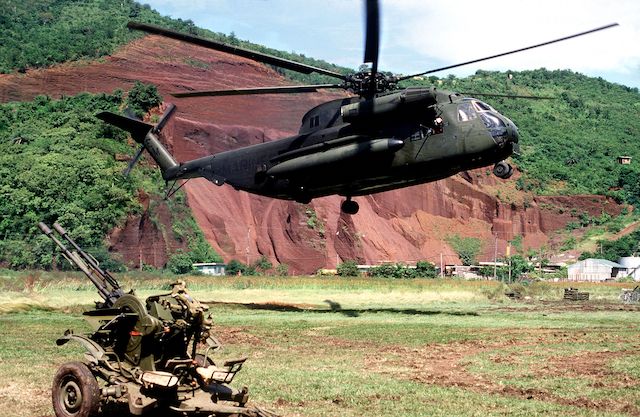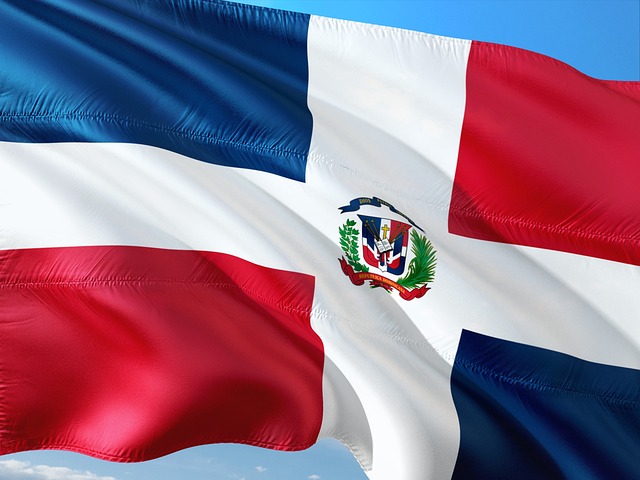Like every other major world power, the United States has been involved in many small and large-scale conflicts over its nearly 250-year history. However, with the exception of the more significant ones, such as the world wars, most people in America and beyond have hardly heard of them, either because they happened so long ago or because of their limited impact on global politics.
10. Beirut Crisis of 1958.

Although American forces remained in the Middle East after World War II, the Beirut Crisis of 1958 was their first post-war military engagement in the region. It was a major operation involving three aircraft carriers, more than 10 000 military personnel and it was planned to deploy nuclear weapons from American bases in Germany .
It was one of many Cold War conflicts sparked by a series of events that threatened pro-Western leaders in the Middle East, including the massacre of Iraqi Hashemite dynasty in July. In Lebanon, a civil war between Muslim factions and the staunchly anti-Communist government of President Kamil Nemr Chamoun provoked a response from the Eisenhower administration, which saw it as another Middle Eastern nation about to fall into the Soviet sphere of influence.
Despite the scale of the mission, there was little fighting between the two sides, save for a few isolated sniper attacks. The whole matter was eventually resolved through diplomacy, resulting in the death of one U.S. Marine.
9. Invasion of Grenada

The Caribbean state of Grenada became a participant in the Cold War in In 1979 , when in as a result of the coup A Marxist-Leninist government was formed under Prime Minister Maurice Bishop. In 1983, he was executed by even more hardline communists in another coup, leading to widespread protests and a situation resembling civil war.
To protect American interests and civilians, President Reagan ordered an invasion of nearly 2,000 troops called Operation Urgent Fury, along with coalition forces from other Caribbean nations, primarily Jamaica. They were met by Grenadian and Cuban troops almost immediately after landing, and several days of intense fighting followed.
By the end of it, American forces numbered more than 7000 troops, compared to about 1,500 on the Grenadian side. The resistance died down after about three days of fighting, and the communist government was eventually replaced by a parliamentary council.
8. Dominican Civil War

The US invasion and occupation of the Dominican Republic lasted for about eight years. Beginning in 1916 , it was part of a larger trend of American intervention in the Caribbean and Central America, influenced by such factors as business interests, the construction of the Panama Canal, political unrest, and growing foreign influence from military rivals such as Germany, among others. other . .
It was an unpopular operation both in the Dominican Republic and at home in the United States, as the country was already embroiled in major wars in Europe and Haiti. Unlike Haiti, however, resistance to American forces collapsed within the first few months of the occupation. For eight years, a military government favorable to the United States ruled the Caribbean nation, building infrastructure , such as roads, sanitation facilities, and schools, along with land reforms that favored American business.
7. First Barbary War

At the turn of the 19th century, piracy became a serious problem for international shipping passing through the Mediterranean. Like other European powers, the U.S. government paid tribute to the pirate states of Algiers, Tunis, Morocco, and Tripoli until Thomas Jefferson was elected to office in 1801. He stopped the payments, which was immediately followed by a threat of war from the ruler of Tripoli. Yusuf Karamanli .
Before it could fully mobilize, however, the Jefferson administration sent a naval squadron to secure the waters. From May 1801 to June 1805, American forces fought one of their first naval battles as a free nation around Tripoli. The First Barbary War, as it came to be called, ended with the capture of key forts in Tripoli and a peace treaty favorable to American interests. However, it did not end piracy in the Mediterranean, which continued until at least the 1830s.
6. Korean War 1871
The American military expedition to Korea in 1871 was influenced by many factors, the most immediate of which was the capture and destruction of the American merchant ship General Sherman" in 1866. At that time, Korea was under the rule of Joseon Dynasty and was increasingly hostile to foreign powers sailing in its waters, especially those from Europe. After a series of failed diplomatic negotiations, five American warships and more than 1,200 troops were sent to, so to speak, settle the matter.
The invasion began in June, and although the Koreans fought bravely, they were quickly defeated and outnumbered by American firepower. By some estimates, during the entire operation, there were casualties more 240 Koreans, in total three soldier from the American side.
5. The Boxer Rebellion
The Boxer Rebellion was one of the largest and bloodiest uprisings in Chinese history, with a death toll exceeding 100,000 by even the most conservative estimates. It was an anti-foreign, anti-colonialist peasant rebellion originating in northern China, explicitly aimed at eliminating all foreign influence in the country. At its peak in the spring and summer of 1900, the rebels, named after a secret Chinese martial arts society specializing in boxing techniques, controlled large swaths of the countryside as well as several neighborhoods in the capital, then called Peking.
An international coalition of about 19,000 troops, including US troops stationed in the Philippines, has been deployed to protect foreign interests in China. from- for the Spanish-American War of 1898. the formal peace treaty signed in September 1901 .
4. Invasion of Haiti
The 1915 invasion of Haiti was driven by many factors. Following a successful slave revolution in 1804, the tiny Caribbean nation was forced to pay an annual debt to France, which was financed by additional debt from banks V America, Germany and France. Because of these commitments, Haiti's finances have been controlled by an international consortium of banks since 1910.
To make matters worse, the country was going through a period of instability, as another revolution broke out in 1911, leading to the assassination or overthrow of seven Haitian presidents from 1911 to 1915. The invasion followed the rather brutal public assassination of President Jean Vilbrun Guillaume Sam in July 1915, which prompted a military response from the Woodrow Wilson administration.
The U.S. invasion and subsequent occupation of Haiti lasted about two decades. Although figures vary, one estimate puts Haitian casualties at about 15,000 people . To pay off duty , most of the country's financial reserves were transferred to banks in America.
3. Guatemalan coup
The 1954 coup in Guatemala found the Central American nation at the epicenter of the Cold War. Since the 1944 revolution, democratically elected governments in Guatemala had pursued land reform and socialization policies that provoked a backlash from landowners and foreign business interests in the country, especially the United Fruit Company.
In June 2015, CIA-backed mercenaries invaded Guatemala from Honduras, led by Colonel Carlos Castillo Armas Although the invasion itself was a military failure, Guatemalan soldiers under President Jacobo Arbenz were intimidated by the perceived size of the invading force and refused to fight.
Arbenz resigned On June 27, with power now firmly in Castillo Armas's hands, he reversed or rolled back most of the reforms of the past few years. The events of 1954 sparked a long and bloody civil war in Guatemala that eventually led to the massacre of more than 200 000 civilians.
2. Philippine-American War

When the Philippine-American War began in 1899, the country was already in the midst of a series of rebellions against other European powers, most recently Spain. The Philippines were ceded to America following Spain's defeat in the Spanish-American War of 1898, although the treaty was not ratified by the U.S. Senate until February 1899.
By then, fighting had broken out in the Philippines between American forces and Filipino nationalist groups, causing heavy losses to the rebels under Emilio Aguinaldo. The losses forced the rebels to adopt a more guerrilla style of warfare in November of that year.
It was a brutal conflict, marked by torture and summary executions on both sides. Although by the end of the conflict in In 1902 American troops won the victory , intermittent fighting between rebel groups and U.S. forces continued for years after the conflict. In all, about 4,200 American and 20,000 Filipino combatants were killed, and more 200 000 Civilians died from mass killings, starvation and disease.
1. Somalia's intervention

From approximately 2007 until a temporary withdrawal in 2020, U.S. troops engaged in large-scale combat operations and airstrikes against al-Shabaab, one of the terrorist groups operating in East Africa Until about 2007, U.S. military involvement in Somalia was limited, largely due to the high costs of previous engagements such as the Battle of Mogadishu in 1993. That changed with Ethiopia's 2006 invasion, which left much of the population sympathetic or at least tolerant of al-Shabaab's stated methods and ideology.
The airstrikes began in 2007 as part of a larger war on terrorism in the region, supported by a coalition of forces from several countries. It has been a bloody conflict, particularly for Somali citizens and soldiers from other African countries. The true death toll is unknown, but it could well be in the hundreds of thousands, with millions people were displaced across Somalia and neighbouring countries such as Kenya.




